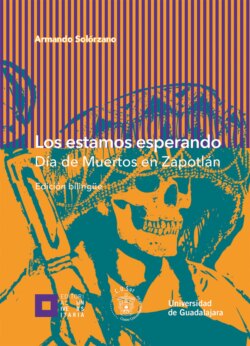Читать книгу Los estamos esperando - Armando Solórzano - Страница 10
Presentation
ОглавлениеAdolfo Espinoza de los Monteros Cárdenas
The Centro Universitario del Sur (CUSUR), an extension of the Universidad de Guadalajara, is comprised of 21 municipalities and maintains constant communication with their authorities and local civil societies. It takes as its mission the development of individuals and the communities they form. Accordingly, two priorities frame the academic work of CUSUR: the promotion of economic development and the fostering of cultural foundations that give rise to social identities and individual subjectivities
Culture shapes our perceptions of the world, the way we understand “the other,” and engenders in us a sense of historical responsibility and respect for people. In congruence with these principles, during my tenure as Director of the Centro Universitario (2008-2013), I had the joy and honor to create two programs that sought to preserve and promote the culture of Zapotlan, thereby advancing the mission and academic purpose of the Centro.
The first project was the creation of the CUSUR, Theater Company, which to this day plays a critical role in the celebration of the Día de Muertos and gives local artists opportunities to enhance and share their talents. The second consisted of the creation of the “Hugo Gutiérrez Vega Colloquium,” a site for intellectual inquiry and research specifically in the areas of the humanities, social sciences, and cultural studies as they pertain to Jalisco and its southern region. Furthermore, I had the pleasure of supporting the civil association “Faith, Tradition, Art, and Indigenous Culture of Zapotlan A.C.” which fostered harmonious connection and collaboration among the many folkloric dance groups in the city.
In this context, Dr. Solórzano shared with us his intention to write a book on the celebration of the Día de Muertos in Zapotlán. We did not hesitate to support his idea, since CUSUR was already involved in the partial financing and organization of this annual event. His project coincided with one of our academic objectives: the dissemination of knowledge not only within academic spheres, but within popular spheres as well. This goal allows people to recognize themselves as creators of their history and to validate their culture, regardless of their economic, ideological, religious or political positions. Holding steadfastly to these premises, we believe that responsible and committed scholarship plays an integral role in the social transformations we seek for our communities.
Thus, Armando Solórzano offers us in this book an important photographic documentation of this celebration, a complex and ancient celebration that vividly demonstrates the syncretism created by the amalgamation of indigenous beliefs and European Christianity in the valley of Zapotlán. He narrates and analyzes how religious, cultural, and spiritual intermixing gave life to this unique celebration in our state, which seeks to recreate and maintain the collective consciousness of the Tlayacanque people, who strive to answer the essential questions about life and its twin sister, death.
Photography is one of the most relevant methods in contemporary research, in part because it can be interpreted as a historical document, an analytical text, and art. Fueled by the proliferation of cameras in cellular phones and other mass technologies, photography has lost meaning; because of its transient nature it is easily destroyed as soon as the electronic devices run out of memory or because the photos are replaced for new ones that will also face the same destiny. But as art and as an object of knowledge, photography opens up new possibilities for analysis and brings the observer to interpret reality in a different way. More important is the fact that photography is a vital instrument in the study of the history of anonymous people, of people who have been marginalized by dominant cultural-religious practices. Through photography, we capture peoples’ history, their daily lives, their interactions. Therefore, this book is an unfinished work; it is an invitation for people to discover themselves and give their meaning to each photograph, page after page. It is also a call to recreate the history of our people and an instrument that unites us in a collective consciousness that shapes the identity of the zapotlenses. The book is an exhortation to recreate the complex dualities of life and death, and to transform them into symbols of freedom and transcendence.
To write this book, the author collected thousands of photographs over four years. Systematically, he sorted the photographs into different thematic categories and selected those most representative of the people and their celebration. With each photo, there is a short text that invites the reader to reflect beyond the images shown in the pages.
The methodology and research techniques employed in the creation of this work are based on the principles of qualitative research. Under this paradigm, photography becomes a relevant source in the reconstruction of the history and culture of minority groups pushed to the margins of society. In accordance with these principles, this work aims to open dialogue between academicians, researchers, communities excluded from formal education, as well as the people who create and recreate culture and express it in popular language.
From the beginning, we wanted to reach a vast and diverse audience. We know that many native people of Zapotlan reside in the United States and Canada; some speak exclusively the english language. Our english-speaking readers are also included in this bilingual edition that will facilitate an understanding of the culture and the ancestral celebrations, and the idiosyncrasies of the people.
The Centro Universitario del Sur, through the administration over which I presided, is pleased to finance this publication and to reaffirm its academic commitment to the ancestral culture of Zapotlán. And just as our ancestors climbed to the roofs of their houses to invite their dead to visit them, so the Centro Universitario del Sur, from the top of the academic peak tells the inhabitants of Zapotlan and the southern region of Jalisco: “Come to our classrooms soon, we are waiting for you”.
